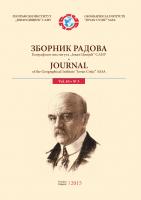Tornado Frequency In The Usa — Meteorological And Non-Meteorological Factors Of A Downward Trend
Tornado Frequency In The Usa — Meteorological And Non-Meteorological Factors Of A Downward Trend
Author(s): Dragan Burić, Vladan Ducić, Jovan MihajlovićSubject(s): Geography, Regional studies, Recent History (1900 till today), Methodology and research technology
Published by: Географски институт »Јован Цвијић« САНУ
Keywords: tornado; trends; air temperature; global warming; Fujita Scale; USA;
Summary/Abstract: Citing numerical simulations, climate alarmists believe that global warming will lead to more frequent and more intensive tornadoes. Considering temperature increase data in the contiguous USA, this study has investigated the trend of strong tornadoes in F3+ category in the 1954–2012 period. Statistically significant decrease of tornadoes per year at an average rate of 0.44 has been recorded, that is, 4.4 tornadoes per decade. Tornado increase has been recorded with F0 and F1 categories and the cause of this increase lies in meteorological and non-meteorological factors. By using upper and lower standard deviation values, the stages of tornado activity have been singled out. The 1957–1974 period may be considered as an active stage and the 1978–2009 period as an inactive stage. Upward trend of air temperature increase does not correspond with the downward trend of the number of F3+ tornado category, while the correlation coefficient between these two variables is R = −0.14. This fact does not correspond with the simulation results and output data of various numerical models anticipating an increase in the number and intensity of tornado events in the conditions of surface air temperature growth.
Journal: Зборник радова Географског института "Јован Цвијић" САНУ
- Issue Year: 65/2015
- Issue No: 3
- Page Range: 269-280
- Page Count: 12
- Language: English

